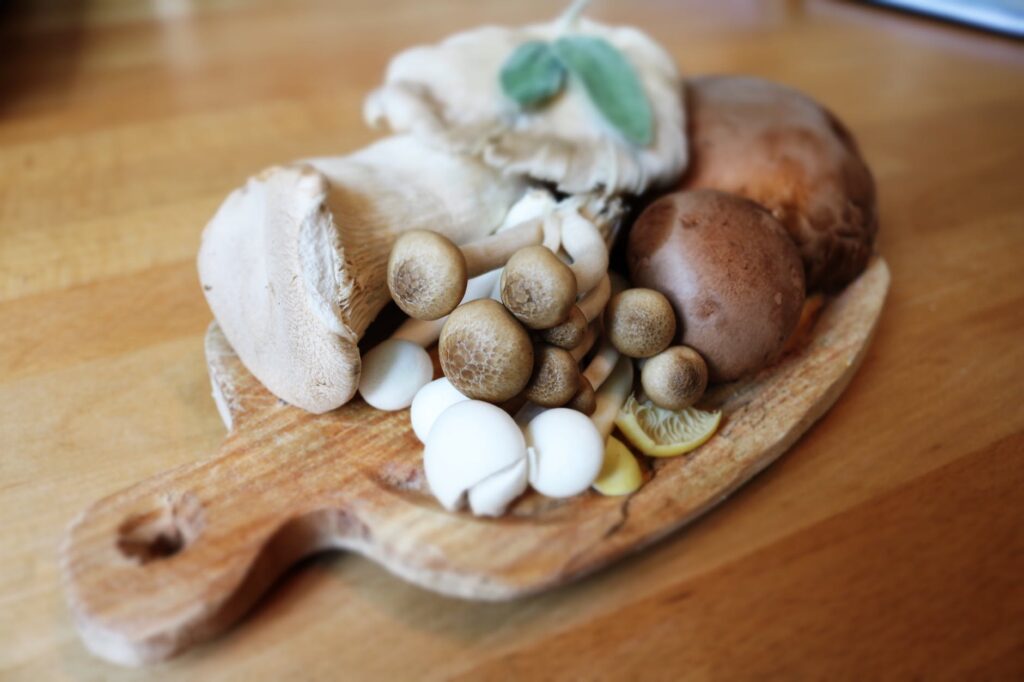What are mushrooms? What are the health benefits of eating mushrooms? Let’s find out.
Mushrooms are a form of fungus despite the fact that they are occasionally regarded as vegetables. Mushrooms resemble plant fruit in certain ways. The mushroom fungus forms under the mushroom’s top and produces millions of microscopic spores, which are released instead of seeds. They can grow on the surface of a food source, above ground, or on top of the soil.
Native to Europe and North America, mushrooms are prized for their meaty texture and subtle flavor.
Their incredible health benefits are also well known. Mushrooms are a terrific addition to your diet because they are full of critical vitamins and minerals and taste delicious in a variety of recipes.
Varieties of mushrooms
Fungi are thought to have more than a million species. Mushrooms can grow in different sizes and colors.

Fungi comprise only a minor portion of edible mushrooms. One of the most popular kinds of mushrooms, creminis, is utilized in kitchens all around the world.
Other kinds of mushrooms that can be eaten are
- Portobello
- Porcini.
- Shitake
- An oyster
- Chanterelle
- Enoki Morel
- The truffles.
Truffles are commonly regarded as mushrooms; however, they are actually a form of fungus. They grow and look different from regular mushrooms, though. Unlike other mushrooms, truffles are brown and have a rough feel. They also lack stems. Additionally, they develop subterranean, affixed to tree roots.
While many mushrooms grow year-round, truffles only grow for a few months of the year and have a greater taste and fragrance than other mushrooms.
Seven Health Benefits of mushrooms
Despite being a fungus, most Americans still include mushrooms in their meals. According to the U.S. Department of Agriculture, it is estimated that the typical American consumes three pounds of mushrooms annually. There’s even more justification to include mushrooms in your diet now.
Without adding a lot of fat, calories, or sodium, mushrooms give food a wonderful flavor. The health advantages don’t end there, either. Scientists are still learning how eating mushrooms can prevent chronic illness and enhance general health. Continue reading to learn seven health benefits of mushrooms:
1. Reduce the likelihood of cancer
Eating just 18 grams of mushrooms (about an eighth of a cup or two medium mushrooms) per day can reduce your risk of cancer by as much as 45%, according to an assessment of 17 cancer studies conducted between 1966 and 2020. Ergothioneine, an amino acid and antioxidant that either prevents or slows down cellular damage, is abundant in mushrooms.
Ergothioneine levels are higher in some mushroom types (shiitake, oyster, maitake, and king oyster). However, they discovered that eating any kind of mushroom every day will reduce your chance of developing cancer.
2. Consume less sodium
Elevated blood pressure and sodium levels frequently coexist. The body retains more fluid when exposed to sodium, which can raise blood pressure. If you want to cut back on sodium, think about using mushrooms in your meals.

The sodium content of mushrooms is naturally low; a full cup of white button mushrooms contains only five milligrams of sodium. Because of their delicious flavor, you won’t need to use as much salt to maintain low blood pressure. A classic ground beef recipe can have its flavor preserved and its sodium content reduced by 25% by substituting half of the meat with mushrooms, according to a study from the Culinary Institute of America and UC Davis.
3. Encourage a reduction in cholesterol
When it comes to cutting down on fat, calories, and cholesterol, mushrooms are a great alternative to red meat. Particularly, shiitake mushrooms, according to research, support reduced cholesterol. They contain substances that reduce the total quantity of cholesterol, prevent cholesterol from being absorbed, and limit the creation of cholesterol.
4. Preserve mental wellness
The impact of consuming mushrooms on mild cognitive impairment (MCI) is still being investigated by researchers. Memory loss and linguistic impairments are brought on by MCI, which frequently precedes Alzheimer’s disease.
Those who consumed more than two cups of mushrooms each week had a 50% lower chance of acquiring MCI, according to a Singaporean study. Even those who consumed just one cup benefited in some way. The participants consumed oysters, shiitake, and golden and white button mushrooms.
5. Offer a vitamin D source.
Our must obtain vitamin D to absorb calcium in order to maintain and grow healthy bones. Many people only receive vitamin D from sunshine or supplements, but if you want to obtain it from your food, mushrooms might be the solution. They contain the only form of vitamin D among vegetables.
Certain mushrooms can boost their quantities of vitamin D when exposed to sunlight, just like people can. After being exposed to UV light or sunlight, white button, portabella, and cremini mushrooms yield the highest levels of vitamin D. Slicing three mushrooms (or one portabella) and letting them sit in the sun for at least fifteen minutes will provide you with the daily required quantity. Without exposure to the sun, consuming a little over a cup of maitake mushrooms does the same purpose.
6. Encourage gut health
Your mood and general well-being are greatly influenced by the bacteria and organisms that live in your gut microbiome. Using prebiotics, like mushrooms, to encourage the growth of beneficial bacteria in your gut is one method to maintain its health.
Studies reveal that the most prevalent carbohydrates found in mushrooms, called polysaccharides, promote the growth of beneficial microorganisms. While stomach acid breaks down many foods, the polysaccharides in mushrooms get through the stomach unaltered and can enter the colon to promote the growth of bacteria there.
7. Encourage a robust immune system
Macronutrients included in mushrooms help maintain a strong immune system. The Mushroom Council claims that the nutrients in mushrooms, which include selenium, which aids in the production of antioxidant enzymes in the body that guard against cell damage, can strengthen your immune system. For the greatest benefit, go for portabella or cremini mushrooms.
Vitamin D strengthens the immune system, lowers inflammation, and aids in cell formation. Maitake mushrooms provide a simple approach to increasing your diet’s vitamin D intake.
Vitamin B6 aids in the synthesis of proteins, DNA, and red blood cells in your body. For vitamin B6, shiitake mushrooms are the best option.
Nutrition for Mushrooms
Mushrooms have an abundance of protein, fiber, and antioxidants at a low-calorie cost. Additionally, they might reduce the chance of getting major illnesses like diabetes, cancer, heart disease, and Alzheimer’s.
They’re excellent resources for:
- Mineral Selenium
- Thiamin Copper
- magnesium
- phosphorous
Nutrients in each serving
Whole cremini mushrooms in a cup provide:
- 15 calories
- 2.2 grams of protein
- 0.1 grams of fat
- Grams of carbohydrates: 3.7
- 0.5 grams of fiber
- 1.5 grams of sugar
Sizes of portions
A cup of finely chopped mushrooms is thought to be the standard serving size. Mushrooms have an umami taste that makes them a great meat alternative in a lot of recipes.
How to Cook on a Mushroom
In practically any grocery or health food shop, you may find mushrooms in the produce area. Additionally, they are simple to raise at home.

Cremini mushrooms can be eaten unsliced or sliced, raw or cooked. They can be sautéed on a hot skillet or boiled in a pot of water for about five minutes until they become tender. When sautéing, place the mushrooms in a pan with olive oil over medium heat and cook, stirring constantly, for about 8 minutes or until the edges begin to brown.
Try to add a little extra texture and taste to your meals by sprinkling raw chopped mushrooms over them. Just remember to give them a thorough cleaning beforehand.
Here are a few well-liked methods for increasing your intake of mushrooms:
- Incorporate mushrooms into your homemade pizza.
- On salads, scatter chopped cremini mushrooms.
- Sauté mushrooms in butter and garlic to make a delicious side dish.
- Pasta sauce should have them added.
- Add mushrooms to turkey, chicken, or beef that has been cooked.
- Prepare the mushroom cream soup.
- Combine them with other vegetables in a stir-fry.
- In the morning, eat eggs and mushrooms.
Mushrooms in a Can
In order to can mushrooms, growers slice fresh mushrooms and then package the pieces in brine. The cans are then sealed and put through a pressure canning procedure.
The components in canned mushrooms are the same as those in fresh mushrooms. But because the brine used to can them is so salty, they might contain a lot of sodium.
Foraging for Mushrooms
Foraging for wild mushrooms is also known as mushrooming. Foragers may take pleasure in the pursuit for a number of reasons, such as:
Researching. Foraging for mushrooms requires knowledge of and accuracy in identifying certain types of mushrooms. Many poisonous mushrooms have similar appearances to edible ones. Thus, it can be challenging to find and identify different types of mushrooms, and it might take years to become an expert at this ability. Among other things, knowledgeable mushroom foragers may recognize different species and comprehend their respective settings.
To Conclude On Health Benefits of Mushrooms
Since many mushroom species are dangerous and can be difficult to differentiate from edible varieties, it is generally not advised to gather mushrooms from the wild. On the other hand, some foragers search for mushrooms with the intention of cooking them.
When selecting mushrooms for cooking, it’s vital to keep in mind certain guidelines, such as picking them from cleaner areas, sorting them according to species, and gathering them in a mesh bag rather than a plastic one. Expert foragers can even get certification to sell mushrooms to nearby eateries.
